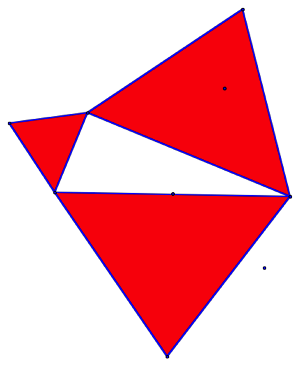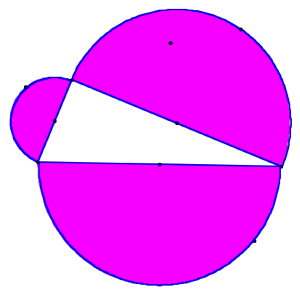Pythagorean Cuts – Introduction
The Theorem of Pythagoras is arguably the most famous theorem in all of mathematics. There is evidence that the relationship between the lengths of the sides of a right triangle has been known to virtually every culture across time and geography. While many proofs have been published by, or attributed to, various sources and persons, the proof presented by Euclid of Alexandria ca. 280 BCE remains unmatched in its simplicity and elegance. In his Elements, Book I, Prop. 47 (I.47), Euclid stated the relationship between sides of the triangle purely geometrically:
Let right triangle ABC be given with the right angle at B. If squares are constructed on each of the sides, then the sum of the areas of the square on AB and the square on BC equals the area of the square on AC (see Figure 1, below).

Figure 1: The Theorem of Pythagoras from Euclid's Elements. The "Pythagorean cut," line segment LK, is shown in red.
Euclid's proof was purely geometric (see Figure 1): He showed that segment BK divides the largest square AJHC into two rectangles, each of which has the same area as one of the smaller squares.
In more modern notation, Euclid I.47 says this:
Given a right triangle with sides of lengths \(a, b,\) and \(c,\) with \(c\) as the longest side, then
\[a^2 + b^2 = c^2.\]
Algebraically, for any positive constant \(k,\) this equation generalizes as follows: \[ka^2 + kb^2 = kc^2.\] One can’t help but notice that different values of \(k\) correspond to different geometric interpretations. For example, \(k ={\frac{1}{2}}\) corresponds to "1 by 2" rectangles, rather than squares, being constructed on each side of the right triangle. Likewise, the value of \(k ={\frac{\sqrt 3}{4}}\) corresponds to equilateral triangles being constructed on each side. Similarly, \(k ={\frac{\pi}{8}}\) corresponds to semicircles being constructed on each side, with the radius equal to half of the length of the side of the triangle on which it is constructed (see Figure 2, below).
|
|
|
|
Figure 2: The Pythagorean Theorem generalized to rectangles, triangles, and semi-circles
The equation \[ka^2 + kb^2 = kc^2\] suggests that the Pythagorean relationship holds for any three similar figures constructed on the three sides of a right triangle. However, Euclid's Elements was written a thousand years before algebraic language would appear and about eighteen hundred years before there was a workable algebraic notation. This led us to wonder:
Can the Pythagorean relationship still be demonstrated geometrically for figures other than squares?
More specifically, how could the largest of the three figures be naturally partitioned, or cut, into two regions, each having area equal to that of one of the two smaller figures?


